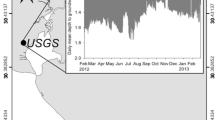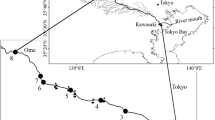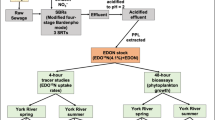Abstract
Massive anthropogenic acceleration of the global nitrogen (N) cycle has stimulated interest in understanding the fate of excess N loading to aquatic ecosystems. Nitrate (NO3 −) is traditionally thought to be removed mainly by microbial respiratory denitrification coupled to carbon (C) oxidation, or through biomass assimilation. Alternatively, chemolithoautotrophic bacterial metabolism may remove NO3 − by coupling its reduction with the oxidation of sulfide to sulfate (SO4 2−). The NO3 − may be reduced to N2 or to NH4 +, a form of dissimilatory nitrate reduction to ammonium (DNRA). The objectives of this study were to investigate the importance of S oxidation as a NO3 − removal process across diverse freshwater streams, lakes, and wetlands in southwestern Michigan (USA). Simultaneous NO3 − removal and SO4 2− production were observed in situ using modified “push-pull” methods in nine streams, nine wetlands, and three lakes. The measured SO4 2− production can account for a significant fraction (25–40%) of the overall NO3 − removal. Addition of 15NO3 − and measurement of 15NH4 + production using the push–pull method revealed that DNRA was a potentially important process of NO3 − removal, particularly in wetland sediments. Enrichment cultures suggest that Thiomicrospira denitrificans may be one of the organisms responsible for this metabolism. These results indicate that NO3 −-driven SO4 2− production could be widespread and biogeochemically important in freshwater sediments. Removal of NO3 − by DNRA may not ameliorate problems such as eutrophication because the N remains bio-available. Additionally, if sulfur (S) pollution enhances NO3 − removal in freshwaters, then controls on N processing in landscapes subject to S and N pollution are more complex than previously appreciated.





Similar content being viewed by others
References
Addy K, Kellogg DQ, Gold AJ, Groffman PM, Ferendo G, Sawyer C 2002. In situ push-pull method to determine ground water denitrification in riparian zones. J Environ Qual 31:1017–24
Aminot A, Kirkwood DS, Kerouel R 1997. Determination of ammonia in seawater by the indophenol-blue method: evaluation of the ICES NUTS I/C 5 questionnaire. Mar Chem 56:59–75
Bernot MJ, Dodds WK 2005. Nitrogen retention, removal, and saturation in lotic ecosystems. Ecosystems 8:442–53
Bonin P 1996. Anaerobic nitrate reduction to ammonium in two strains isolated from costal marine sediment: a dissimilatory pathway. FEMS Microbiol Ecol 19:27–38
Bottcher J, Strebel O, Voerkelius S, Schmidt HL 1990. Using isotope fractionation of nitrate nitrogen and nitrate oxygen for evaluation of microbial denitrification in a sandy aquifer. J Hydrol 114:413–24
Burgin AJ, Hamilton SK 2007. Have we overemphasized the role of denitrification in aquatic ecosystems? A review of nitrate removal pathways. Front Ecol Environ 5:89–96
Carpenter SR, Caraco NF, Correll DL, Howarth RW, Sharpley AN, Smith VH 1998. Nonpoint pollution of surface waters with phosphorus and nitrogen. Ecol Appl 8:559–68
Dannenberg S, Kroder M, Dilling W, Cypionka H 1992. Oxidation of H2, organic compounds and inorganic sulfur compounds coupled to reduction of O2 or nitrate by sulfate-reducing bacteria. Arch Microbiol 158:93–9
Fazzolari E, Mariotti A, Germon JC 1990. Dissimilatory ammonia production vs. denitrification in vitro and in inoculated soil samples. Can J Microbiol 36:786–93
Forshay KJ. 2003. Nitrogen dynamics in floodplain water bodies following inundation on the Wisconsin River floodplain. M.S. Thesis. University of Wisconsin, Madison, WI
Fossing H, Gallardo VA, Jorgensen BB, Huttel M, Nielsen LP, Schulz H, Canfield DE, Forster S, Glud RN, Gundersen JK, Kuver J, Ramsing NB, Teske A, Thamdrup B, Ulloa O 1995. Concentration and transport of nitrate by the mat-forming sulfur bacterium Thioploca. Nature 374:713–5
Gallardo VA 1977. Large benthic microbial communities in sulfide biota under Peru Chile subsurface countercurrent. Nature 268:331–2
Golterman HL, Clymo RS 1969. Methods for chemical analysis of freshwaters. Oxford: Blackwell
Groffman PM, Altabet MA, Bohlke JK, Butterbach-Bahl K, David MB, Firestone MK, Giblin AE, Kana TM, Nielsen LP, Voytek MA 2006. Methods for measuring denitrification: diverse approaches to a difficult problem. Ecol Appl 16:2091–122
Guerrero RE, Montesinos E, Pedrós-Alió C, Esteve I, Mas J, van Gemerden H, Hofman PAG, Bakker JF 1985. Phototrophic sulfur bacteria in two Spanish lakes: vertical distribution and limiting factors. Limnol Oceanogr 30:919–31
Haaijer SCM, Van der Welle MEW, Schmid MC, Lamers LPM, Jetten MSM, Op den Camp HJM 2006. Evidence for the involvement of betaproteobacterial Thiobacilli in the nitrate-dependent oxidation of iron sulfide minerals. FEMS Microbiol Ecol 58:439–48
Haaijer SCM, Lamers LPM, Smolders AJP, Jetten MSM, den Camp HJMO 2007. Iron sulfide and pyrite as potential electron donors for microbial nitrate reduction in freshwater wetlands. Geomicrobiol J 24:391–401
Hamilton SK, Ostrom NE 2007. Measurement of the stable isotope ratio of dissolved N2 in 15N tracer experiments. Limnol Oceanogr Methods 5:233–40
Hauck S, Benz M, Brune A, Schink B 2001. Ferrous iron oxidation by denitrifying bacteria in profundal sediments of a deep lake (Lake Constance). FEMS Microbiol Ecol 37:127–34
Holmes RM, McClelland JW, Sigman DM, Fry B, Peterson BJ 1998. Measuring N-15NH4 + in marine, estuarine and fresh waters: an adaptation of the ammonia diffusion method for samples with low ammonium concentrations. Mar Chem 60:235–43
Istok JD, Humphrey MD, Schroth MH, Hyman MR, OReilly KT 1997. Single-well, ‘‘push-pull’’ test for in situ determination of microbial activities. Ground Water 35:619–31
Jorgensen B 1982. Ecology of the bacteria of the sulphur cycle with special reference to anoxic-oxic interface environments. Philos Trans R Soc Lond 298:543–61
Jorgensen BB, Gallardo VA 1999. Thioploca spp: filamentous sulfur bacteria with nitrate vacuoles. FEMS Microbiol Ecol 28:301–13
Kelly DP 1999. Thermodynamic aspects of energy conservation by chemolithotrophic sulfur bacteria in relation to the sulfur oxidation pathways. Arch Microbiol 171:219–29
Kelly DP, Wood AP 2000. Confirmation of Thiobacillus denitrificans as a species of the genus Thiobacillus, in the beta-subclass of the Proteobacteria, with strain NCIMB 9548 as the type strain. Int J Syst Evol Microbiol 50:547–50
King D, Nedwell DB 1985. The influence of nitrate concentration upon the end-products of nitrate dissimilation by bacteria in anaerobic salt-marsh sediment. FEMS Microbiol Ecol 31:23–8
Koretsky CM, Haveman M, Beuving L, Cuellar A, Shattuck T, Wagner M 2007. Spatial variation of redox and trace metal geochemistry in a minerotrophic fen. Biogeochemistry 86:33–62
Korom SF 1992. Natural denitrification in the saturated zone—a review. Water Resour Res 28:1657–68
Laverman AM, Van Cappellen P, van Rotterdam-Los D, Pallud C, Abell J 2006. Potential rates and pathways of microbial nitrate reduction in coastal sediments. FEMS Microbiol Ecol 58:179–92
Lovley DR 1991. Dissimilatory Fe(III) and Mn(IV) reduction. Microbiol Rev 55:259–87
Lovley DR, Klug MJ 1983. Sulfate reducers can out-compete methanogens at freshwater sulfate concentrations. Appl Environ Microbiol 45:187–92
Lucassen ECHET, Smolders AJP, Roelofs JGM 2002. Potential sensitivity of mires to drought, acidification and mobilisation of heavy metals: the sediment S/(Ca + Mg) ratio as diagnostic tool. Environ Pollut 120:635–46
Ludwig W, Strunk O, Westram R, Richter L, Meier H, Yadhukumar, Buchner A, Lai T, Steppi S, Jobb G, Forster W, Brettske I, Gerber S, Ginhart AW, Gross O, Grumann S, Hermann S, Jost R, Konig A, Liss T, Lussmann R, May M, Nonhoff B, Reichel B, Strehlow R, Stamatakis A, Stuckmann N, Vilbig A, Lenke M, Ludwig T, Bode A, Schleifer KH 2004. ARB: a software environment for sequence data. Nucleic Acids Res 32:1363–71
Luthy L, Fritz M, Bachofen R 2000. In situ determination of sulfide turnover rates in a meromictic alpine lake. Appl Environ Microbiol 66:712–7
Matheson FE, Nguyen ML, Cooper AB, Burt TP 2003. Short-term nitrogen transformation rates in riparian wetland soil determined with nitrogen-15. Biol Fertil Soils 38:129–36
McGuire JT, Long DT, Klug MJ, Haack SK, Hyndman DW 2002. Evaluating behavior of oxygen, nitrate, and sulfate during recharge and quantifying reduction rates in a contaminated aquifer. Environ Sci Technol 36:2693–700
Megonigal J, Hines M, Visscher P 2004. Anaerobic metabolism: linkages to trace gases and aerobic processes. In: Schlesinger WH Ed. Biogeochemistry. Oxford, UK: Elsevier-Pergamon. pp 317–424
Morkved PT, Sovik AK, Klove B, Bakken LR 2005. Removal of nitrogen in different wetland filter materials: use of stable nitrogen isotopes to determine factors controlling denitrification and DNRA. Water Sci Technol 51:63–71
Mulholland PJ, Helton AM, Poole GC, Hall RO, Hamilton SK, Peterson BJ, Tank JL, Ashkenas LR, Cooper LW, Dahm CN, Dodds WK, Findlay S, Gregory SV, Grimm NB, Johnson SL, McDowell WH, Meyer JL, Valett HM, Webster JR, Arango C, Beaulieu JJ, Bernot MJ, Burgin AJ, Crenshaw C, Johnson L, Merrian J, Niederlehmer BR, O’Brien JM, Potter J, Sheibley RW, Sobota DJ, Thomas SM 2008. Excess nitrate from agricultural and urban areas reduces denitrification efficiency in streams. Nature 452:202–6
Philippot L, Hojberg O 1999. Dissimilatory nitrate reductases in bacteria. Biochimica Et Biophysica Acta Gene Struct Expression 1446:1–23
Postma D, Boesen C, Kristiansen H, Larsen F 1991. Nitrate reduction in an unconfined sandy aquifer—water chemistry, reduction processes, and geochemical modeling. Water Resour Res 27:2027–45
Sayama M, Risgaard-Petersen N, Nielsen LP, Fossing H, Christensen PB 2005. Impact of bacterial NO3 − transport on sediment biogeochemistry. Appl Environ Microbiol 71:7575–7
Schlesinger WH 1997. Biogeochemistry: an analysis of global change, 2nd edn. San Diego: Academic Press
Seitzinger S, Harrison JA, Bohlke JK, Bouwman AF, Lowrance R, Peterson B, Tobias C, Van Drecht G 2006. Denitrification across landscapes and waterscapes: a synthesis. Ecol Appl 16:2064–90
Smith MS 1982. Dissimilatory reduction of NO2 − to NH4 + and N2O by a Soil Citrobacter Sp. Appl Environ Microbiol 43:854–60
Soares MIM 2002. Denitrification of groundwater with elemental sulfur. Water Res 36:1392–5
Tiedje JM 1988. Ecology of denitrification and dissimilatory nitrate reduction to ammonium. In: Zehnder AJB, Ed. Biology of anaerobic microorganisms. New York: Wiley. pp 179–244
Timmer-ten-Hoor A 1981. Cell yield and bioenergetics of Thiomicrospira denitrificans compared with Thiobacillus denitrificans. Antonie Van Leeuwenhoek J Microbiol 47:231–43
Vitousek PM, Aber JD, Howarth RW, Likens GE, Matson PA, Schindler DW, Schlesinger WH, Tilman DG 1997. Human alteration of the global nitrogen cycle: sources and consequences. Ecol Appl 7:737–50
Weber KA, Achenbach LA, Coates JD 2006. Microorganisms pumping iron: anaerobic microbial iron oxidation and reduction. Nat Rev Microbiol 4:752–64
Whitmire SL 2003. Anaerobic biogeochemical functions of Michigan wetlands and the influence of water source. Ph.D. Dissertation. Michigan State University, East Lansing, MI
Whitmire SL, Hamilton SK 2005. Rapid removal of nitrate and sulfate in freshwater wetland sediments. J Environ Qual 34:2062–71
Zedler JB 2003. Wetlands at your service: reducing impacts of agriculture at the watershed scale. Front Ecol Environ 1:65–72
Acknowledgments
We would like to thank the following people for their help and advice: A. Gold, P.M. Groffman, J. Ledbetter, J. Lennon, T. Loecke, W. Mahaney, W. Metcalf, G.P. Robertson, T. Schmidt, K. Smemo, D. Weed, and S. Whitmire. In particular, we thank the MBL Microbial Diversity summer course for providing a platform for the enrichment work and providing the funds for the sequencing. This includes K. DeAngelis, S. Eichorst, T. Teal, and D. Woebken. We also thank N. Ostrom, P. Ostrom, and H. Gandhi for help with the isotope measurements. Two anonymous reviewers provided feedback that also improved the manuscript. This work was supported by US National Science Foundation grants DEB-0111410, 0508704, 0423627, and 0516076. This is contribution #1460 of the WK Kellogg Biological Station.
Author information
Authors and Affiliations
Corresponding author
Electronic supplementary material
Below is the link to the electronic supplementary material.
Rights and permissions
About this article
Cite this article
Burgin, A.J., Hamilton, S.K. NO3 −-Driven SO4 2− Production in Freshwater Ecosystems: Implications for N and S Cycling. Ecosystems 11, 908–922 (2008). https://doi.org/10.1007/s10021-008-9169-5
Received:
Revised:
Accepted:
Published:
Issue Date:
DOI: https://doi.org/10.1007/s10021-008-9169-5




